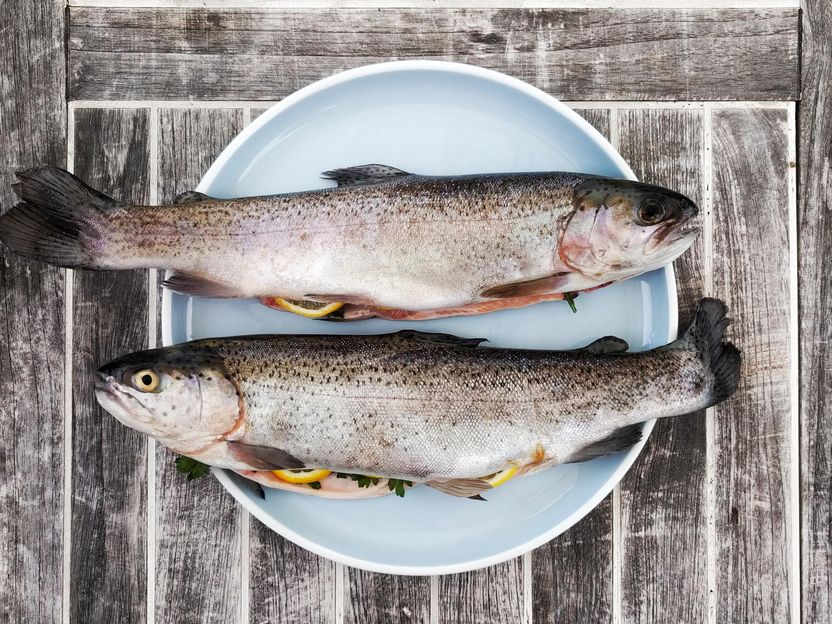6 myths about salmon: what's really true?
For years, salmon has been one of the most popular food fish, in 2020 it was even in first place in Germany. Especially during the Christmas season, it is often on the table. Almost all salmon products in our supermarkets come from aquaculture.

Photo by Gregor Moser on Unsplash
But farmed salmon is often criticised. It is bad for the environment and full of antibiotics. Is this really true? It's time to dispel the most common myths about farmed salmon.
1. farmed salmon is full of antibiotics
This assumption persists, but it is false. After all, it's not just us humans who can avert many diseases with preventative measures like hygiene. The same applies to fish farming. The use of antibacterial drugs could be massively reduced, in the case of salmon from Norway by 99 percent. In a recent study by Stiftung Warentest, no antibiotic residues were found in the farmed salmon tested.
2. 5 kilos of wild fish are needed for one kilo of farmed salmon.
This figure has long been outdated, but comes up again and again. Today, on average, less than one kilo of wild fish is needed. Currently, fish meal and oil make up less than 30 percent of farmed feed. Much of this now comes from leftovers from processing. The rest is made up of land-produced ingredients, such as wheat, corn and soy. These ingredients should also come from responsible sources, which is why the Aquaculture Stewardship Council's (ASC) standards include requirements for marine as well as plant-based ingredients.
Salmon is just one of many farmed species. A look at the entire global aquaculture industry shows that only 220 grams of wild fish are used for every kilo of farmed fish and crustaceans produced.
3. salmon farming is factory farming under water
In any form of animal husbandry, consideration should be given to animal welfare and thus to the needs of the species in question. This is also the case in fish farming. In Norwegian salmon farms, the fish are only allowed 2.5 percent of the space in the enclosure, the rest is water. This gives them plenty of room to swim. Shoaling fish, on the other hand, like it cuddlier and stay together, even if they have more space.
4. salmon farming causes dead sea beds
Like food production on land, salmon farming in the ocean has an impact on the soil. ASC-certified salmon farmers must demonstrate that they are maintaining the ecosystem under (and around) their farm(s) by measuring chemical and biological parameters, such as the quality and composition of animals and plants living on the seafloor. Additional fallow periods, times when the enclosures are empty, give the seabed the opportunity to regenerate. In this way, the seabed and its inhabitants can be protected.
5. control of salmon lice damages the environment
Salmon lice are marine parasites that infest salmon and trout in the sea - both wild and farmed. They feed on the skin and muscles of the fish, making the animals sick. ASC standards require keeping salmon healthy and not harming the environment. This is exactly why farmers in many places now use biological pest control with cleaner fish, salmon lice traps, bubble nets around the farms, and many other non-medical measures.
6 Salmon farming is purely about profit for large companies.
As in almost every industry, salmon farming varies widely, from global companies that farm in multiple countries to family farms that form cooperative ventures. What they have in common: Most salmon farms are located in remote regions and, together with fish processing, are the lifeline and often the only source of income for small communities, in Norway as much as in Chile or Iceland. So big does not always equal bad. The big companies in particular invest a lot in research, from which the entire industry benefits. Moreover, if they work more sustainably, it has a much greater impact than with small farms.
So all in all, we can conclude: Farmed salmon is better than its reputation. After all, there have been a number of improvements in salmon farming in recent years. For example, the use of antibiotics has been greatly reduced and the feed composition optimised. In addition to laws, it is above all certifications such as those of the ASC that have driven improvements and innovations in salmon farming.
Note: This article has been translated using a computer system without human intervention. LUMITOS offers these automatic translations to present a wider range of current news. Since this article has been translated with automatic translation, it is possible that it contains errors in vocabulary, syntax or grammar. The original article in German can be found here.






























































